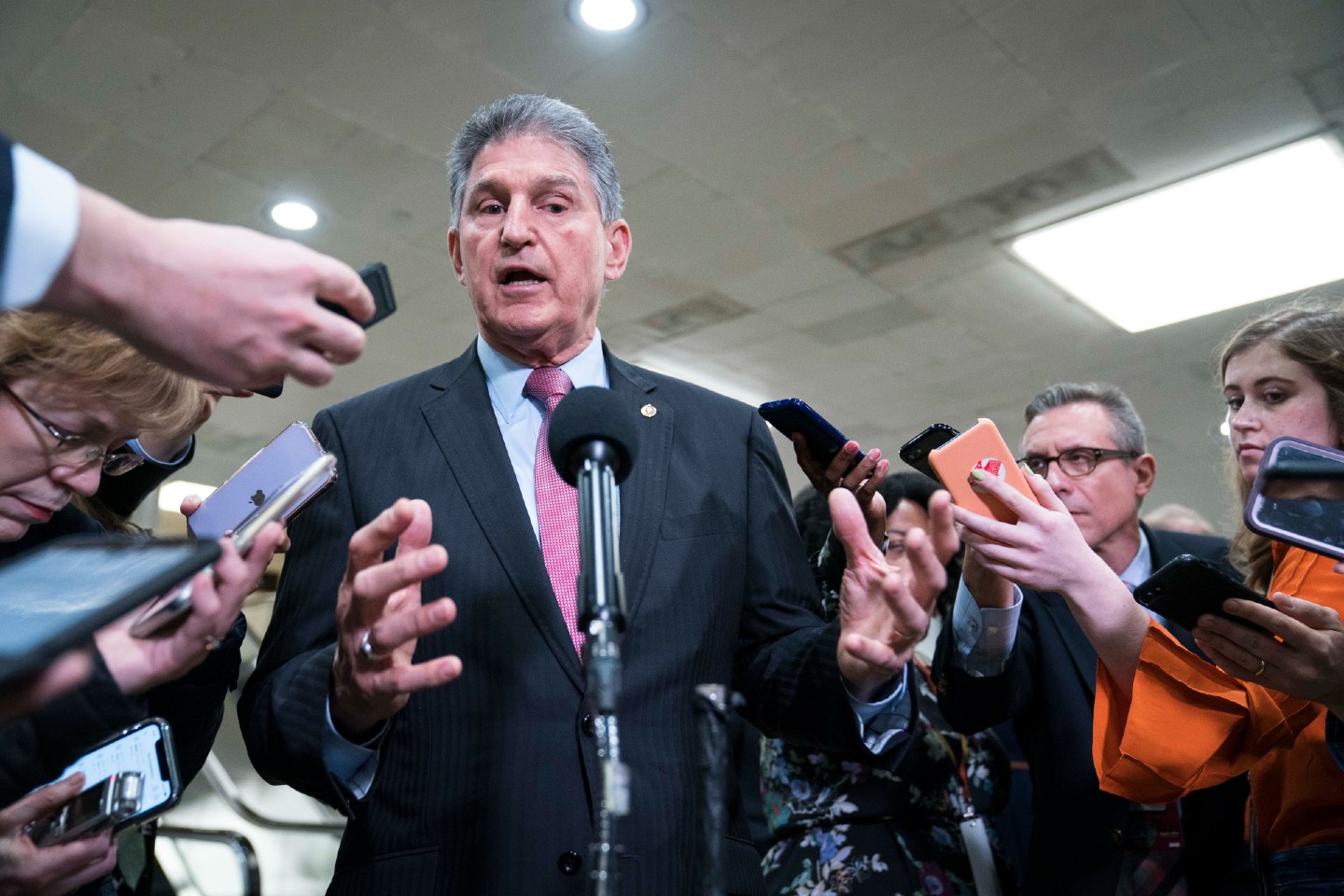
On the heels of Democratic victories in both Senate runoffs in Georgia, securing a 50-50 party split in the Senate, the realization followed: conservative Democrat Sen. Joe Manchin was now one of the most powerful people in Washington. Manchin often votes with Republicans and will be able to single-handedly block Democratic bills from passing the Senate.
If Democrats want to quickly enact further pandemic relief and start voting in the Senate on progressive bills, they’ll have to evade filibustering tactics. The most direct ways to advance bills to a Senate vote would involve changing its standing rules. With a 50-50 Senate and a tiebreaker in Vice President Harris, Democrats have no room for defections when it comes to parliamentary rules changes, even those that require a simple majority.
Manchin is proclaiming himself an implacable fan of the filibuster, a position shared by fellow centrist Sen. Kyrsten Sinema of Arizona. Shortly after Election Day, Manchin took the opportunity to tour the media circuit and trumpet that he would defend the filibuster in this two-year Congress.
The former governor of West Virginia who first won his Senate seat in 2010, Manchin holds up to $5 million in non-public stock in a family coal business, with up to $1 million in dividends over 2019-2020, even as he is set to take the gavel of the Senate Energy and Natural Resources Committee. As a politician who once shot a climate bill with a rifle in a campaign ad, it’s safe to say he’s not too keen for the Senate to hold a majority vote on climate legislation that would transition the country to renewable energy.
“I will not vote to bust the filibuster under any condition, on anything that you can think of,” Manchin told the Washington Post. “If you can’t sit down and work with your colleagues on the other side and find a pathway forward, then you shouldn’t be in the Senate.”
But in his many media appearances over the sanctity of the filibuster, it was never mentioned that Manchin voted in January 2011 in favor of several Senate rules changes that had the effect of reducing the filibuster’s power. While the reforms that Manchin supported then did not completely eliminate the ability for senators to filibuster, they are similar to several possible rule changes that could allow Democrats to hold majority votes on bills this year, even without “abolishing” the filibuster. Chief among the changes that Manchin voted for in 2011, which didn’t pass, was a return to the “talking filibuster,” known from its portrayals in popular culture.
Viewers of Manchin’s blustering appearances on Fox News or CNN might not realize how recent the abuse of the filibuster is, historically. It was just in 1975 that the underlying Senate rule was most recently amended, reducing the number of votes required to invoke cloture from 67 to 60, which ends debate on a bill and moves it to consideration (unless lawmakers unanimously agree to move it to a vote). The sharp rise in filibustering in the past 14 years, as measured by cloture motions filed, led to the blocking of widely-popular legislation that had majority support in the Senate, but fell short of the notorious 60-vote threshold needed to earn a final vote. The overall effect of the Senate filibuster has been to make an already unrepresentative institution even more profoundly undemocratic.
Amending the underlying Senate Rule 22 that establishes the cloture process would require a two-thirds supermajority, making that route very unlikely, given Republican opposition. But a simple majority of senators can pursue “reform by ruling,” also called the “nuclear option,” and establish a new precedent with Vice President Harris as presiding officer. This process of interpreting Senate rules was generally what was followed in 2013 and 2017 by leaders of each party to end unlimited debate on certain nominations.
Subtle But Substantive Filibuster Reform Options
If the nuclear option was used to reinstate the talking filibuster for legislation in this Congress, Democrats would probably be able to actually hold votes on bills, for a change—that is, if Manchin and Sinema stay in the fold with their colleagues and go along with the rules changes. But the two senators have insisted they’re not open to filibuster fixes, though in practice it has meant senators from small states overruling those who represent the majority of the U.S. population. There’s no sign that Minority Leader Mitch McConnell is practicing bipartisanship or relenting on obstruction. It’s now February and he still hasn’t agreed to the Democrats’ organizing resolution that would allow committees to appoint new Democratic chairs.
Several progressive Democratic senators recognized the problem of the filibuster in the first term of the Obama administration, and introduced Senate resolutions then to reduce its obstructive impacts. On Jan. 5, 2011, freshman Sen. Tom Udall of New Mexico introduced S. Res. 10, a bill that targeted two main areas: ending the practice of secret holds, and returning to a talking filibuster requirement—as he put it, “in the simplest terms, it’s bringing a filibuster back to ‘Mr. Smith Goes to Washington.’ You stand up, and you have to speak on the issue you really care about.”
The ending of secret holds did pass, as did a measure preventing senators from requiring bill text to be read aloud as a stalling tactic, as negotiated by Sen. Chuck Schumer (D-N.Y.) and Sen. Lamar Alexander (R-Tenn.).
But the resolution for talking filibuster, which required a two-thirds majority to pass, fell short. On Jan. 27, 2011, it received 44 “ayes.” (Sen. Jeff Merkley of Oregon noted they actually had 46 backers.) Among the talking filibuter’s supporters was Manchin, who put out a press release that day stating, “The new rules we adopted today will ensure that we’re operating with greater transparency, and that the views of regular Americans are better represented in the Senate.”
Now, Senate Democrats again have a menu of options to bring bills to a vote even if they don’t currently have Manchin and Sinema’s vote to eliminate the filibuster. The “Mr. Smith” rule is an option for Majority Leader Schumer, as a way to force Republicans to exert tremendous energy explaining why they’re blocking votes on bills with at least 50 senators in support. More exceptions to filibusters, like the one for budget reconciliation bills, could be added for other measures, such as the democracy reform package H.R. 1. Requiring a talking filibuster in this Congress would seem to be right in line with the Senate traditions that Manchin espoused a decade ago—and in the midst of the legislative churn in a couple months, maybe his opposition to completely eliminating the filibuster will erode.
One last historical point to observe in how the Democrats arrived at this point of seeing so many of their bills languish in the Senate because of the filibuster: these reform-by-ruling changes could have been pursued by Democratic Senate leaders in the past. Under then-Majority Leader Harry Reid of Nevada, Democrats started the 111th Congress of 2009 with at least 57 votes, eventually rising to 60, when progressives called on Reid to go nuclear to pass an adequate stimulus. After the experience of the 111th Congress, and after the Citizens United decision of Jan. 2010, Democrats could have changed the rules at the start of the 112th Congress of 2011, as they were urged to do by an open letter of over 300 scholars and legal experts. But the Udall and Merkley coalition of 46 senators came up short of the 67 votes needed for the resolution, and Reid did not support implementing the reform by ruling changes with a simple majority.
After the record-setting expenses of the 2012 election, where 81% of dark money was estimated to benefit Republican candidates, Democrats could have changed the rules in the 113th Congress of 2013—but Sen. Reid demurred, instead striking a deal with Mitch McConnell on filibuster reform regarding nominees outside of cabinet appointments and Supreme Court nominations. In summer of 2019, Reid revised his position in a New York Times op-ed and called for an end to the legislative filibuster, but the consequences of not holding Senate votes on issues like a public health care option or climate legislation or immigration reform had already been felt by hundreds of millions of Americans.
For more coverage of Senate gridlock and options for congressional reform, sign up for our free email newsletter.
